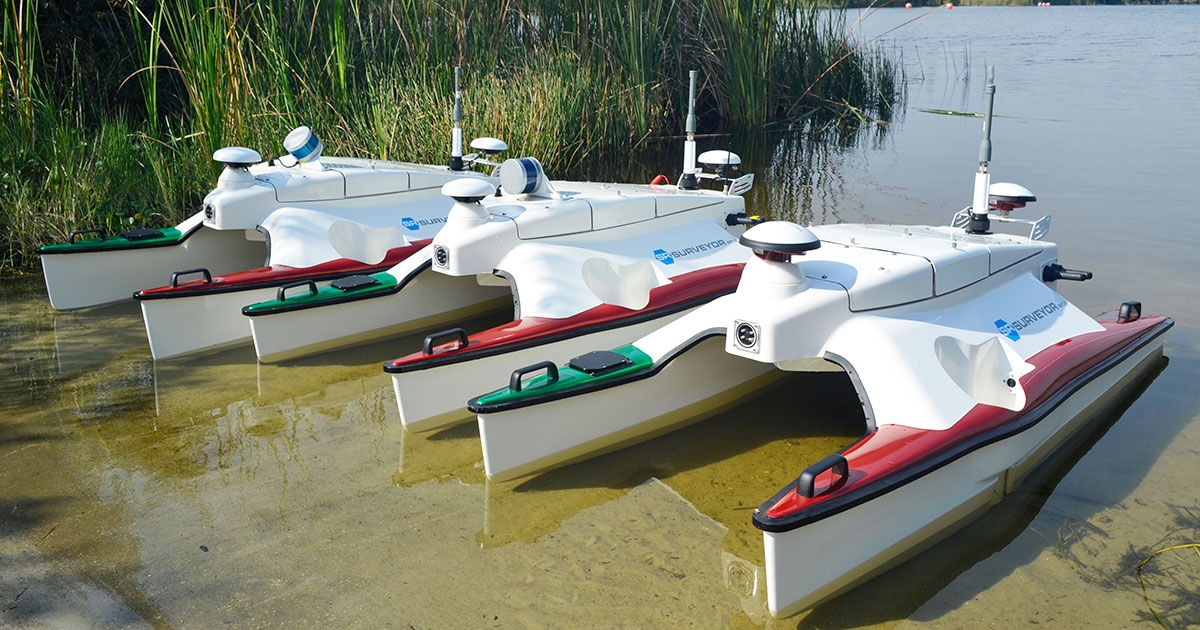In recent decades, marine robotics has proven to be the key enabling technology in the execution of increasingly complex at-sea missions. One clear manifestation of this is the ascendency of Autonomous Surface Vehicles, or ASVs. While early ASVs (back in the 1990s) were mostly inspired by aquaculture, modern-day advances in multibeam sonar, data processing, and GNSS positions have ushered in a new era of high-quality data acquisition. Today, ASVs are the preferred means of instrumentation among hydrographers.
PARADIGM SHIFT
Although the use of unmanned surface vehicles still lags somewhat behind other branches of marine robotics, such as ROVs and AUVS, the surging interest in ASVs is testament to how technologists continue to redefine the way we work at sea. In 2021, regardless of application or domain, operators are increasingly motivated to deploy automated marine systems in the name of efficiency gains (by reducing topside support) and safety (by keeping people out of harm’s way).
This trend is evident in the growing market for rapidly deployable, plug and play systems built for surveyors looking to chart hazardous, remote to access, or hard-to-navigate waters. The premise is simple—these agile, robust ASVs unlock the potential for increasingly remote operations, allowing hydrographers to spend less time on the water collecting data and more time on dry land interpreting real-time, decision-critical information.
SR-SURVEYOR M1.8
Since its inception in 1999, SeaRobotics has designed and manufactured a range of pioneering ASVs, from compact, tightly integrated units to more sizable hulls equipped for challenging offshore activities. More recently, however, the Florida-based team has concentrated efforts on developing industry-leading man-portable ASVs for inland and coastal survey. This ongoing R&D push culminated in the launch of the SR-Surveyor M1.8, in 2019.
“We have a twenty-year track record of custom engineered ASV solutions to fit very specific customer requirements,” explains SeaRobotics’ VP Programs Lou Dennis. “This partnership, with both the private and public sectors, has afforded us exclusive and valuable insight into how our clients see ASV technology influencing their day-to-day practices in the near and mid-term future. This cumulative experience helped us identify a gap in the market for an easy-to-use ASV like the SR-Surveyor M1.8, engineered to streamline survey logistics and optimize data capture for bathymetric studies, habitat mapping, structure inspection and search and rescue efforts.”
UPDATED FOR 2021
The speed at which the Blue Economy is advancing means that there is an almost constant drip-feed of sensor tweaks and software upgrades, all geared to extend and enhance ASV functionality. Updated for 2021 is the SR-Surveyor M1.8’s, is the integration of EdgeTech’s DW 4-24kHz Sub-Bottom Profiler with the EdgeTech 2205, delivering large swath data collection with unmatched efficiently and accurately.
The hull payload bays, are tightly packed into the pontoons, are designed to support ACDPs (Acoustic Doppler Current Profiler) or Dual Frequency Single Beams, as well as an AML micro SV sensor to capture surface sound velocity measurements. The ASV’s 16 channel mapping LiDAR Velodyne Puck LiDAR captures a 360-degree view of all data points, making it the ideal feature for inspecting inland and coastal infrastructure, such as near-shore pipelines, bridges, piers, and underwater rigs. Also new for 2021 is the ASV’s integrated onboard ADL Advantage RTK Rover Radio for receiving Base Station broadcasted position corrections.
Put simply, the SR-Surveyor M1.8 is one of the only man-portable systems on the market that offers such a diverse range of data sets simultaneously: two frequencies of side scan, motion tolerant side scan, wide swath bathymetry, backscatter, LiDAR point cloud data, and discharge data, and now sub-bottom profiles—all in a 1.8-meter package.
FORCE MULTIPLIER
Clearly, the more data per survey line the better. The concept of force multiplication is nothing new when it comes to marine survey, but the advent of rapidly deployable ASVs means that multi-boat campaigns are becoming increasingly accessible and straightforward to orchestrate, be them in the shallows or the deep. Compact ASVs of this nature are no longer conceptual; they are instrumental to staying competitive. When it comes to marine survey, ASV utilization—with or without the support of a manned topside vessel—drives efficiencies; fuel consumption, man hours, and the need for high value assets are drastically reduced, which ultimately drives down the cost of data.
So, what’s next for the SR-Surveyor M1.8, in the age of remote survey operations? According to Dennis, the future of ASVs is finally a commercial reality:
“Right out of the box, the SR-Surveyor M1.8 represents the best-in-value for autonomous marine data collection. What’s more, our team of engineers at SeaRobotics is equipped to work with clients to incorporate a certain degree of asset customization. Increasingly, this centers around multi-boat deployment and control. To this end, we are currently working on an XL Module that will provide additional sensor payload capacity, extra propulsion thrusters, extended battery capacity, and heightened communication and command interfacing with other networked sensors packages.”
Read more about Unmanned Vehicles & Marine Robotics in the Ocean News & Technology digital March edition.



